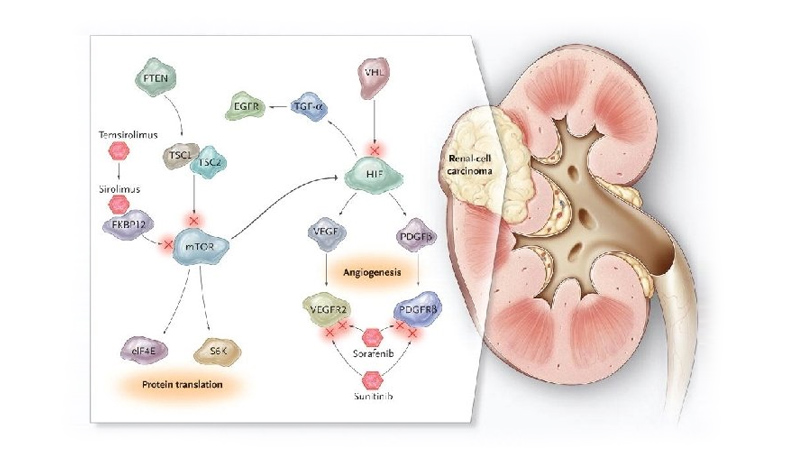Renal Cancer Genomics
(A) EPITHELIAL UROTHELIAL CARCINOMA
(B) CLEAR CELL RENAL CELL CARCINOMA
Multiples Kinases Involved in the Angiogenesis Pathway.

(A) EPITHELIAL UROTHELIAL CARCINOMA
CDKN2A is a tumor suppressor gene. It is a Variants of Uncertain Significance (VUS) here. CTNNB1 explains the possibility of this cancer being hereditary. It’s a rare mutation, but if found they are extremely sensitive to Cisplatin, Cyclophosphamide, Vincristine, Gemcitabine, and Radiation Therapy. ( Here it is detected and pathogenic) Since PIK3CA [NM_006218.4] is detected and pathogenic, it would respond to ALPELISIB in advanced or metastatic stage.
(B) CLEAR CELL RENAL CELL CARCINOMA
Multiples Kinases Involved in the Angiogenesis Pathway.
VEGF: VEGF-C and its receptor, VEGFR-3, are involved in lymph- angiogenesis. Expression of these receptors is seen in endothelial and tumour cells. VEGF-C can induce lymphangiogenesis, lymphovascular invasion and metastasis.
PDGF (Platelet-derived growth factor): promotes tumour neoangiogenesis, which plays a role in tumour progression. PDGF is induced by inactivation of the VHL pathway. High expression of PDGF-β in tumour tissue is associated with poor prognosis for patients with clear cell RCC (ccRCC).
FGFs (Fibroblast growth factor): FGFs and FGFR2 regulate cel- lular proliferation, survival, migration and differentiation, but also promote the formation of blood vessels and are upregulated upon resistance to VEGF- targeted treatment. Endothelial cells respond to FGFs via integrins (cell adhesion) and promote cell adhesion and pro- liferation. FGF/FGFR signalling plays a role in angiogenesis, mitosis and proliferation in the RCC pathway.
mTOR (Mammalian target of Rapamycin): PI3K/AKT/mTOR pathway activation is a result of signal transduction by growth factors. Genitourinary Malignancies 159
It is one of the signalling pathways characteristic of most cells. Phosphatase and tensin homologue (PTEN) is a key suppressor of the PI3K/AKT/mTOR signalling cascade. Its mutations and deletion in primary RCC have been associated with an increased risk of metastasis.
HIF 2 alpha (HIF-2α): The VHL protein (pVHL) is closely related to ccRCC carcinogenesis, as is its function as a subunit of the E3 ubiqui- tin ligase complex, which mediates the degradation of HIF-2α. Under hypoxic conditions, HIF-2α forms an active transcription factor (by binding to HIF-1β) that upregulates expression of hypoxia-inducible genes, such as VEGF.